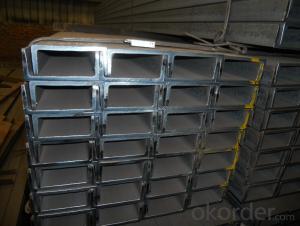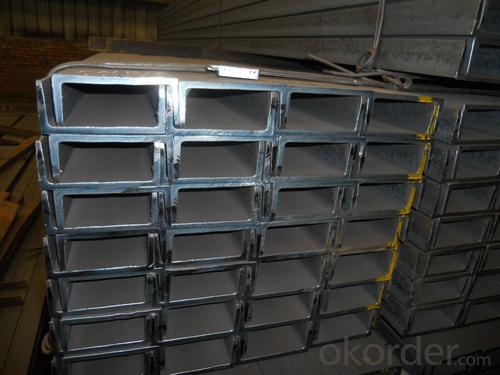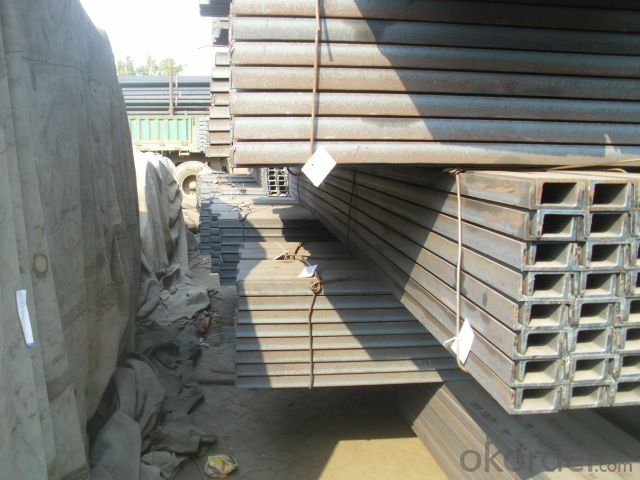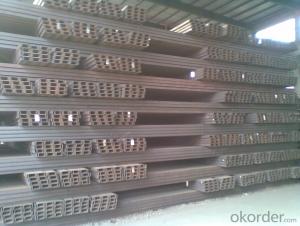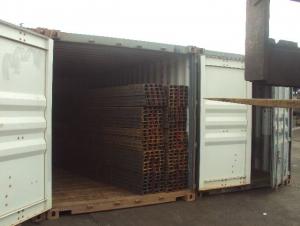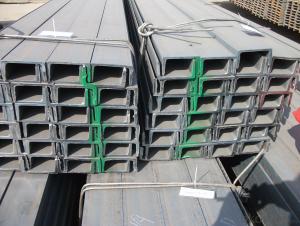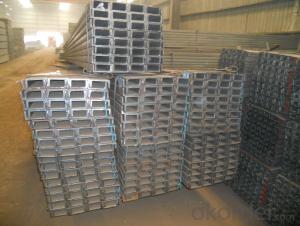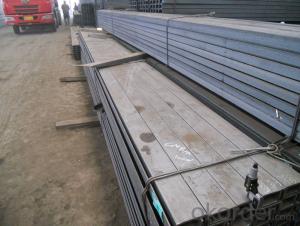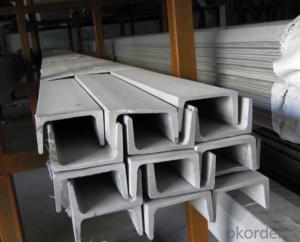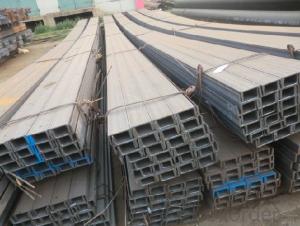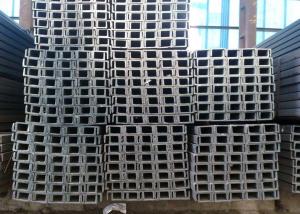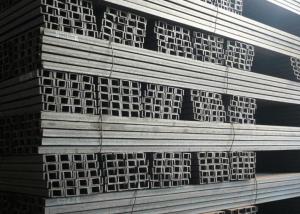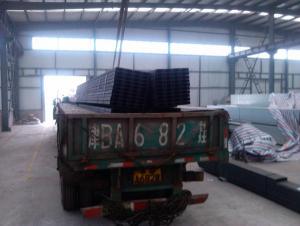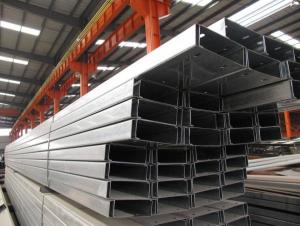U-channel Steel JIS Standard High Quality Hot Rolled
- Loading Port:
- Tianjin
- Payment Terms:
- TT OR LC
- Min Order Qty:
- 25 m.t.
- Supply Capability:
- 2000 m.t./month
OKorder Service Pledge
OKorder Financial Service
You Might Also Like
Product Description:
OKorder is offering U-channel at great prices with worldwide shipping. Our supplier is a world-class manufacturer of steel, with our products utilized the world over. OKorder annually supplies products to European, North American and Asian markets. We provide quotations within 24 hours of receiving an inquiry and guarantee competitive prices.
Product Applications:
1.The JIS channel can be devided into two kinds, namely common channel steel and light channel steel. The sizes of hot rolled common channel steel range from 5# to 40#. Meanwhile, the channel steel can be divided into cold forming sectional equal channel steel, cold forming sectional unequal channel steel, cold forming inner edge channel steel and outer edge channel steel.
2.The JIS channel is usually used for arch-itechtural structure, and they could be welded in order to support or hang a vari-ety of facilities. They are also usually used in combination with I beam. The channel steel with sizes under 14# is usually applied to construction engineering, as purline, while the channel steel with sizes above 16# is more likely to be used in building vehicle chassis structure and mechanical structure. Furthermore, the channel steel in sizes above 30# are target at building bridge structure, as tension bar.
Product Advantages:
OKorder's U-channel are durable, strong, and resist corrosion.
Main Product Features:
· Premium quality
· Prompt delivery & seaworthy packing (30 days after receiving deposit)
· Corrosion resistance
· Can be recycled and reused
· Mill test certification
· Professional Service
· Competitive pricing
Product Specifications:
1.We are able to provide channel steel of top quality at attractive price.
2.Our products of channel steel have passed ISO9001:2008 Quality Management System Certification.
Alloy No | Grade | Element (%) | |||||
C | Mn | S | P | Si | |||
Q235 | B | 0.12—0.20 | 0.3—0.7 | ≤0.045 | ≤0.045 | ≤0.3 | |
Alloy No | Grade | Yielding strength point( Mpa) | |||||
Thickness (mm) | |||||||
≤16 | >16--40 | >40--60 | >60--100 | ||||
≥ | |||||||
Q235 | B | 235 | 225 | 215 | 205 | ||
Alloy No | Grade | Tensile strength (Mpa) | Elongation after fracture (%) | ||||
Thickness (mm) | |||||||
≤16 | >16--40 | >40--60 | >60--100 | ||||
≥ | |||||||
Q235 | B | 375--500 | 26 | 25 | 24 | 23 | |
Note of U-channel
1. According to national standard (GB) for our products, if not, supply according to national standards (GB) or agreement.
2. We can not only provide electric furnace +LF+VD and electros lag re-melting (ESR) steel forging materials, but also forging products of piece, bar, etc.
3. Our company is equipped with roll equipment and can provide our customers with roll billets or finished.
4. The materials that we purchase are all accord with International General Standard; you could check it out on the Material Quality Sheet.
5. We are the creator of the “seven-step inspect method” in China.
6. The technical workers we employed are the ones with many years’ working experience, who know the technology procedures very well.
7. We will strictly inspect our production that we sold according to the customer’s request.
FAQ:
Q1: How soon can we receive the product after purchase?
A1: Within three days of placing an order, we will begin production. The specific shipping date is dependent upon international and government factors, but is typically 7 to 10 workdays.
Q2: What makes stainless steel stainless?
A2: Stainless steel must contain at least 10.5 % chromium. It is this element that reacts with the oxygen in the air to form a complex chrome-oxide surface layer that is invisible but strong enough to prevent further oxygen from "staining" (rusting) the surface. Higher levels of chromium and the addition of other alloying elements such as nickel and molybdenum enhance this surface layer and improve the corrosion resistance of the stainless material.
Q3: How soon can we receive the product after purchase?
A3: Within three days of placing an order, we will begin production. The specific shipping date is dependent
Images:


- Q: Are steel channels suitable for indoor recreational facilities?
- Yes, steel channels are suitable for indoor recreational facilities. Steel channels are commonly used in construction for their durability, strength, and versatility. They can be used for various applications in recreational facilities such as supporting structural elements, framing, and creating partitions or barriers. Steel channels are also resistant to fire, pests, and decay, making them a reliable choice for indoor environments. Additionally, steel channels can be easily customized and installed, allowing for flexibility in design and layout. Overall, steel channels provide a stable and long-lasting solution for indoor recreational facilities.
- Q: Can steel channels be used for overhead crane systems?
- Indeed, overhead crane systems can utilize steel channels. In construction and industrial settings, steel channels are widely employed as structural elements owing to their robustness and resilience. They furnish a stable and secure framework for supporting the diverse constituents of an overhead crane system, encompassing the bridge, trolley, and hoist. Steel channels boast exceptional load-bearing capacity and can endure the arduous loads and strains inherent in crane operations. Moreover, they can be effortlessly fabricated and tailored to conform to the specific requisites of the crane system, encompassing length, width, and thickness. Overall, steel channels represent a dependable and efficient option for overhead crane systems.
- Q: How do steel channels contribute to the overall safety of a structure during earthquakes?
- Steel channels play a crucial role in enhancing the overall safety of structures during earthquakes. One of the main reasons is their ability to provide structural stability and strength. Steel channels are typically used as components of the structural system to distribute and transfer loads. During an earthquake, these channels act as load-bearing members, effectively absorbing and dispersing the seismic forces to prevent localized damage. The shape and form of steel channels allow them to resist lateral forces and provide resistance against bending and twisting motions caused by seismic waves. By distributing the forces evenly throughout the structure, steel channels help in preventing concentrated stress points that could potentially lead to structural failure. Additionally, steel channels are highly durable and resistant to damage, making them ideal for earthquake-prone regions. Their high strength-to-weight ratio allows for the construction of lighter yet robust structures. This reduces the overall mass of the building, which in turn reduces the inertia forces generated during an earthquake and minimizes the likelihood of structural collapse. Furthermore, steel channels can be incorporated into seismic design strategies such as moment resisting frames or braced frames. These systems provide additional rigidity and stiffness to the structure, ensuring that it can withstand the lateral forces exerted by an earthquake. The flexibility of steel channels also allows for the absorption of energy, reducing the impact on the overall structure. In summary, steel channels contribute to the overall safety of a structure during earthquakes by providing structural stability, distributing seismic forces, resisting bending and twisting motions, and reducing mass and inertia forces. Their durability, strength, and ability to absorb energy make them a vital component in earthquake-resistant design strategies.
- Q: What are the different applications of steel channels in the automotive industry?
- The automotive industry extensively uses steel channels due to their versatility and advantageous features. Below are several examples of how steel channels are utilized in the automotive industry: 1. Structural Support: Steel channels are commonly employed to provide structural support in automobile frames, chassis, and body panels. They offer robustness and stiffness, enabling them to bear the vehicle's weight and absorb impact forces during collisions. 2. Reinforcement: Critical areas of the vehicle, such as door frames, pillars, and roof rails, are reinforced using steel channels. This enhances the vehicle's structural integrity and safety, particularly in the event of an accident. 3. Suspension Components: Steel channels are utilized in the production of suspension components, including control arms, sway bars, and trailing arms. These components connect the wheels to the chassis, delivering stability, control, and a smooth ride quality. 4. Bumper Reinforcements: Steel channels are integrated into bumper reinforcements to augment impact resistance and safeguard both the vehicle and its occupants during a collision. They effectively distribute and absorb energy, minimizing damage. 5. Exhaust Systems: Steel channels are utilized in exhaust systems to create the necessary pathways for exhaust gases to exit the vehicle. These channels are designed to withstand the heat, vibrations, and corrosion caused by the exhaust gases. 6. Seat Frames: Steel channels are commonly used in constructing seat frames, ensuring strength and durability. They securely hold the seats in place, providing comfort and safety to the occupants. 7. Roll Cages: Steel channels are employed in fabricating roll cages, which are indispensable safety features in racing vehicles. Roll cages protect the driver in the event of a rollover or crash, preventing the roof from collapsing. To summarize, steel channels play an essential role in the automotive industry, contributing to the strength, safety, and performance of vehicles. Their applications span from providing structural support and reinforcement to manufacturing suspension components, bumper reinforcements, exhaust systems, seat frames, and roll cages.
- Q: What are the factors to consider when determining the appropriate angle of a steel channel?
- When determining the appropriate angle of a steel channel, several factors need to be taken into consideration. Firstly, the intended purpose or function of the steel channel should be considered. Different angles may be suitable for different applications. For example, if the channel is being used as a support or brace, a larger angle may be required to provide sufficient strength and stability. On the other hand, if the channel is being used for aesthetic purposes or to create a specific shape, a smaller angle may be more appropriate. Secondly, the load that the steel channel will be subjected to plays a crucial role in determining the angle. The weight and distribution of the load need to be analyzed to ensure that the chosen angle can withstand the forces and stresses exerted on it. This involves considering factors such as the magnitude and direction of the load, as well as any potential dynamic or impact forces that may be present. Additionally, the material properties of the steel channel should be taken into account. Different types of steel have varying strength, durability, and flexibility characteristics. The appropriate angle will depend on the specific properties of the steel being used, as well as any relevant industry standards or regulations. Furthermore, the fabrication and installation process should be considered. The chosen angle should be feasible to manufacture and install, taking into account factors such as cutting, welding, and assembly techniques. It is essential to ensure that the angle selected can be easily achieved within the available resources and capabilities. Lastly, cost considerations should not be overlooked. Different angles may require varying amounts of steel and fabrication efforts, resulting in different costs. Balancing the desired angle with the available budget is crucial in making an informed decision. In conclusion, the factors to consider when determining the appropriate angle of a steel channel include the intended purpose, load requirements, material properties, fabrication and installation feasibility, and cost considerations. Taking all these factors into account will help ensure that the selected angle is suitable for the specific application and provides the necessary strength and functionality.
- Q: Can steel channels be used in the construction of mezzanine floors?
- Mezzanine floors, which are commonly utilized in industrial and commercial settings to expand available space, can indeed incorporate steel channels. Renowned for their durability and strength, steel channels are frequently employed in construction projects. Within mezzanine floor construction, steel channels serve as beams or joists, offering essential structural support. Their ability to endure substantial loads ensures a dependable and secure platform for various applications, including storage, offices, and additional workspace. Moreover, steel channels can be tailored to meet specific design and structural prerequisites, rendering them an adaptable option for mezzanine floor construction.
- Q: What are the different methods for connecting steel channels?
- There are several methods for connecting steel channels, including welding, bolting, and using mechanical fasteners such as screws or rivets. The choice of method depends on factors such as the structural requirements, load-bearing capacity, and the desired level of flexibility or adjustability in the connection.
- Q: How do steel channels contribute to energy efficiency in buildings?
- Steel channels contribute to energy efficiency in buildings in several ways. Firstly, steel channels are often used as structural components in building frames. These frames provide stability and support to the structure, allowing for the construction of taller buildings with more open floor plans. By using steel channels instead of traditional building materials like wood or concrete, the weight of the building can be reduced, leading to less energy consumption during construction and transportation. Additionally, steel channels are known for their durability and strength. This strength allows for the creation of longer spans and larger openings, which in turn can optimize natural lighting and ventilation in a building. By maximizing the use of natural light, the need for artificial lighting is reduced, resulting in lower energy consumption and cost. Similarly, improved natural ventilation can reduce the reliance on air conditioning systems, resulting in energy savings. Furthermore, steel channels can be used in the construction of energy-efficient building envelopes. Building envelopes are designed to minimize heat transfer between the interior and exterior environment. Steel channels are often incorporated into the framing of walls, roofs, and floors, providing a strong and stable structure that can support insulation materials. This insulation helps to maintain a comfortable indoor temperature year-round, reducing the need for heating or cooling systems and ultimately saving energy. Lastly, steel channels are recyclable, which contributes to the sustainability of a building. At the end of a building's lifespan, steel channels can be easily salvaged and recycled into new steel products. This reduces the demand for virgin materials and minimizes the carbon footprint associated with manufacturing new building materials. Overall, steel channels play a significant role in improving energy efficiency in buildings by reducing construction weight, enabling natural lighting and ventilation, enhancing insulation capabilities, and promoting sustainability through recycling.
- Q: Are steel channels suitable for agricultural buildings?
- Yes, steel channels are suitable for agricultural buildings. Steel channels offer several advantages that make them ideal for agricultural structures. Firstly, steel channels are known for their high strength and durability. They can withstand heavy loads and harsh weather conditions, making them suitable for supporting the weight of agricultural equipment, storing feed, and withstanding the elements. Additionally, steel channels are resistant to pests, such as termites and rodents, which are common in agricultural environments. This makes them a more reliable and long-lasting option compared to other materials that may be susceptible to pest damage. Moreover, steel channels are fire-resistant, reducing the risk of damage or loss in the event of a fire outbreak, which is crucial for the safety of livestock and stored crops. Furthermore, steel channels are highly versatile and can be easily customized to suit the specific needs of agricultural buildings. They can be designed to accommodate various layouts and configurations, allowing for efficient use of space and optimal functionality. Lastly, steel channels require minimal maintenance over their lifespan, reducing the overall cost of ownership for agricultural buildings. This is particularly beneficial in the agricultural sector, where time and resources are often limited. Considering these factors, it is clear that steel channels are a suitable and advantageous choice for agricultural buildings, providing strength, durability, versatility, and cost-effectiveness.
- Q: How are steel channels used in structural applications?
- Steel channels are commonly used in structural applications as they provide structural support and stability. They are often used as beams or columns to carry heavy loads and distribute weight evenly. Steel channels can also be used as stiffeners to strengthen and reinforce structures. Their versatility and durability make them essential components in construction projects, ranging from buildings and bridges to industrial plants and infrastructure.
Send your message to us
U-channel Steel JIS Standard High Quality Hot Rolled
- Loading Port:
- Tianjin
- Payment Terms:
- TT OR LC
- Min Order Qty:
- 25 m.t.
- Supply Capability:
- 2000 m.t./month
OKorder Service Pledge
OKorder Financial Service
Similar products
Hot products
Hot Searches
Related keywords
